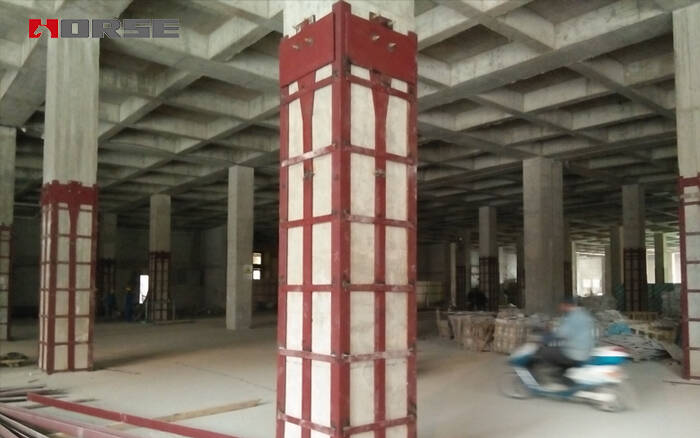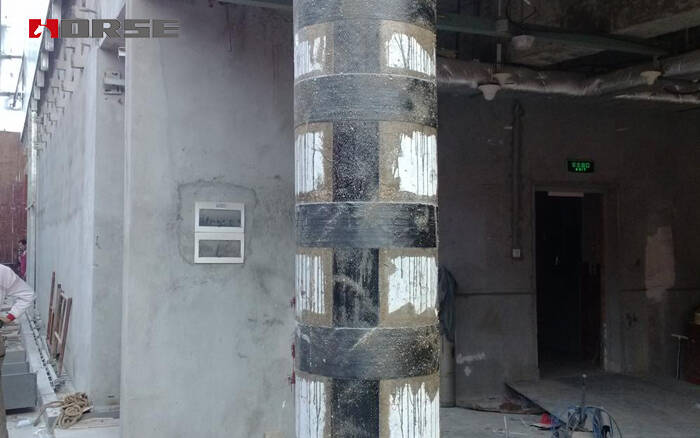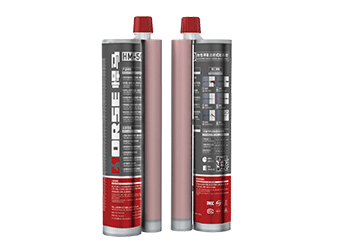Solutions
Horse Construction offers full range of structural strengthening materials with technical supports, documentation supports, products supports, project supports.
column strengthening, concrete strengthening, structural strengthening

Due to factors such as insufficient bearing capacity and changes in use functions, reinforced concrete columns need to be reinforced. Introduce the common reinforcement methods of reinforced concrete columns in civil engineering construction, explain the principles, advantages and disadvantages of various reinforcement methods, and provide references for engineering applications.
With the development of civil engineering construction technology and the development and utilization of new materials, there are more and more reinforcement methods for reinforced concrete columns. Common reinforcement methods include enlarged cross-section reinforcement method, outer steel reinforcement method, external adhesion FRP material reinforcement method, prestressed reinforcement method and composite reinforcement method. Several commonly used reinforcement methods are briefly introduced below.

External bonding FRP material reinforcement method
Pasting FRP (Fiber Reinformed Plastic) material reinforcement method is a new type of reinforcement technology that emerged abroad in the 1980s and 1990s. It uses resin cementing materials to paste carbon fiber fabric on the surface of concrete to achieve the purpose of strengthening and strengthening the structure and improving the structural performance. At this stage, the main research and application in civil engineering are carbon fiber reinforced polymer (CFRP), glass fiber reinforced polymer (GFRP), aramid fiber reinforced polymer (AFRP) and basalt fiber reinforced polymer (BFRP), etc. .
Wrap or wrap the FRP material horizontally around the periphery of the concrete member. When a component undergoes lateral deformation when subjected to a vertical load, FRP can passively provide a restraining force for the concrete, thereby increasing the ultimate compressive strength and ultimate strain of the core concrete, thereby improving the mechanical performance of the concrete column. FRP reinforcement can effectively change the failure mode of concrete columns, avoid shear failure with poor ductility, and significantly improve concrete deformability. At the same time, compared with other traditional reinforcement methods, the external adhesive fiber reinforced plastic reinforcement method has the advantages of corrosion resistance, light weight (almost no increase in structural weight), high strength, and lower maintenance costs. It is suitable for concrete structural members and general structures with various stress properties, but the reinforced structure has poor ductility and insufficient deformation capacity. In addition, since the resin at the bottom of the pasted fiber material is an epoxy structural adhesive, there are problems such as high temperature requirements, easy aging, and special fire prevention treatment. At the same time, since a single FRP cannot meet the needs of structural reinforcement, hybrid fiber composite reinforcement has also been researched and applied at home and abroad in recent years. In order to improve the utilization rate of FRP materials, applying a certain prestress to FRP materials before reinforcement has gradually become a research hotspot.
Prestressed reinforcement method
The main idea of using the prestressed reinforcement method is to apply a part of the pre-conceived force or deformation to reduce or offset the undesired force and deformation. According to the different reinforcement objects, pre-stress method reinforcement can be divided into pre-stressed rod reinforcement and pre-stressed brace reinforcement. The prestressed tie rod reinforcement method is suitable for the reinforcement of large eccentric compression members. The steel tie rods are arranged on the tension side of the compression member. After prestressing, the internal force of the member can be reduced and the bearing capacity of the member can be improved. The axial compression column shall be provided with compression rod limbs on both sides of the reinforcement column. For small eccentric compression columns, the compression rod limbs are set on the side with greater pressure. This method is mainly suitable for concrete load-bearing structures requiring improved bearing capacity, rigidity and crack resistance, and a small space after reinforcement. Especially large-span structures under high stress, such as heavily corroded steel bars. But the disadvantage of this method is that special prestressing equipment is required during construction, and the construction process is more complicated.
Due to the large self-weight of the bridge structure and the generally large span, the pre-stressed reinforcement method has been used more in bridge reinforcement projects due to its inherent advantages. The relevant research on the pre-stressed reinforcement method has also been carried out at home and abroad.
External steel reinforcement method
Reinforcing concrete columns with outer steel is a method of strengthening the four corners of the column with section steel. Its advantages are simple construction, less on-site workload, and more reliable force. According to the different construction technology, the outer steel reinforcement method can be divided into wet and dry outer steel. Among them, dry-clad steel reinforcement is to directly outsource the section steel to the original member, or although it is filled with cement mortar, it cannot guarantee the effective transmission of shear force on the joint surface. The wet-clad steel reinforcement method is to leave a certain gap between the outer profile steel and the original member, and fill it with latex cement slurry or fine stone concrete to bond the two into a whole and work together. Wet reinforcement methods are generally used in engineering.
Generally, the cross-sectional size of the steel-clad reinforcement member is not enlarged much, but its bearing capacity is greatly improved, and the ductility of the member is also greatly improved due to the restraint effect of the laterally-clad steel. This reinforcement method is suitable for the reinforcement of concrete structures that do not allow a large increase in the size of the original member's cross-section, but require a large increase in the load-bearing capacity of the cross-section.
Enlarged section reinforcement method
Enlarged section reinforcement method is a traditional reinforcement method. It is a reinforcement method to increase the strength, rigidity and stability of components or buildings by increasing their cross-sectional area and reinforcement to meet the requirements of normal use of components. The enlarged section method has different forms such as surrounding wrapping, single-sided reinforcement and double-sided reinforcement. Surrounding wrap is to pour concrete around the column, and it is more used in structures that mainly bear axial forces. Single-sided or double-sided is mainly aimed at the column structure that bears a large bending moment at the same time, and the main bearing surface is enlarged. Especially in seismic fortification areas, this can change the original strong beam and weak column into a strong column and weak beam structure that is beneficial to earthquake resistance.
The reinforced column with enlarged section method is different from ordinary concrete members in the mechanical performance. This is because when the cross-section is enlarged, it is generally impossible to completely unload. The reinforced column has been loaded before the reinforcement, and certain stress and strain have been generated in the cross-section. The newly added part cannot immediately share the load that has been applied to the reinforced column after reinforcement, but can only start to work with the reinforced column and bear the load under the action of the new load. In this way, the strain of the newly added part after reinforcement always lags behind the original column. When the reinforced column reaches its limit state, the performance of the newly added steel bars and concrete cannot be fully utilized, which directly brings about problems such as low utilization rate of post-reinforcement materials. The higher the stress level of the concrete column before reinforcement, the worse the reinforcement effect.
You can find anything here you are in need of, have a trust trying on these products, you will find the big difference after that.

two-components modified epoxy resin adhesive, with high quality plastic tube, double cartridge package

Modified epoxy resin structural perfusion adhesive, specifically for supporting adhesive bonded steel reinforcement

High strength, unidirectional carbon fiber fabric pre-saturated to form a carbon fiber reinforced polymer (CFRP) fabric used to strengthen structural concrete elements.